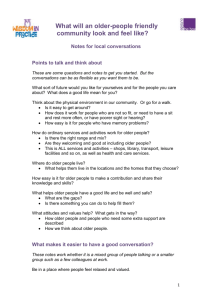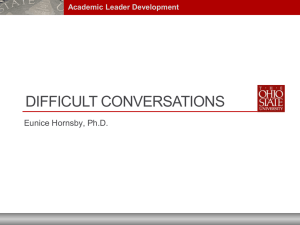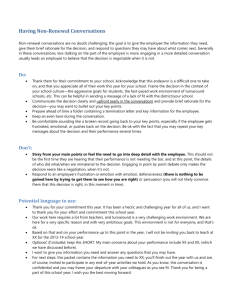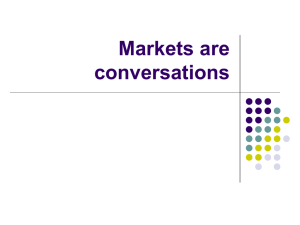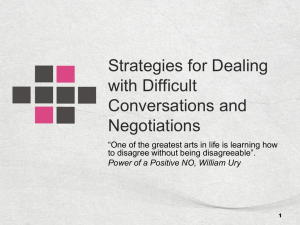PERSONAL EFFECTIVENESS 1
advertisement
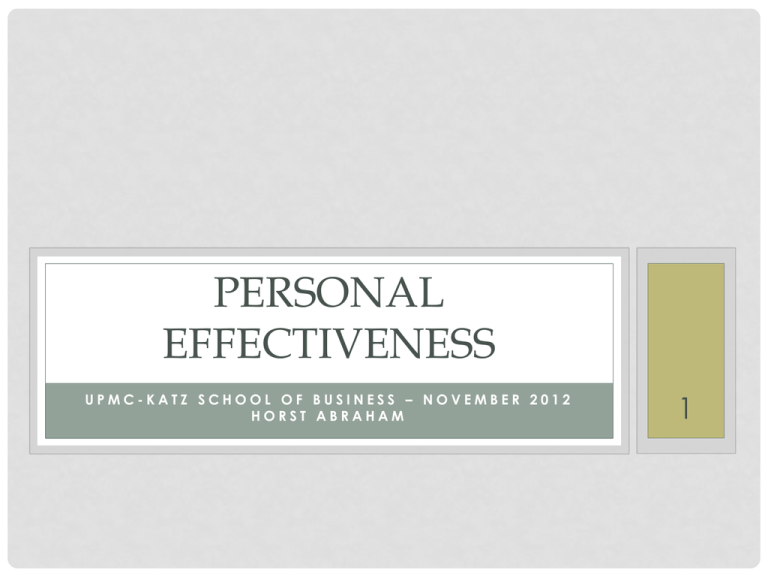
PERSONAL EFFECTIVENESS UPMC-KATZ SCHOOL OF BUSINESS – NOVEMBER 2012 HORST ABRAHAM 1 CONTENTS • • • • • EQ – Managing Self / Managing Others. Personal Best. Values Assessment. Behavior Shifts. Skills and Competencies: Fierce Conversations Case Work – Dealing with difficult situations Coaching Finding my ‘Edge’. Managing Personal Energy. Mapping my personal development 2 ACCORDING TO THE LATEST RESEARCH IQ accounts for what percentage of career success? a. 50 to 60 percent b. 35 to 45 percent c. 23 to 29 percent d. 15 to 20 percent Your answer:___________ 3 THE 5 DIMENSIONS OF EMOTIONAL INTELLIGENCE THE ABILITY TO MANAGE ONESELF 1. Self-Awareness • Knowing one’s own internal values, preferences, styles, and needs, associated with self-confidence 2. Self-Regulation • Self-control, trustworthiness, adaptability, and integrity 3. Self-Motivation • Personal achievement orientation, energy, and an optimistic inclination toward action 4 5 DIMENSIONS OF EMOTIONAL INTELLIGENCE THE ABILITY TO MANAGE OTHERS 4. Empathy • Sensitivity to others’ feelings, needs, and perspectives and the capability to facilitate others’ success 5. Interpersonal Competence • The competence to build strong, mutually reinforcing, life-giving relationships with others 5 PERSONAL BEST • When you are at your best, … 1. _________________________________________ 2. _________________________________________ 3. _________________________________________ 4. _________________________________________ 5. _________________________________________ 6. _________________________________________ 7. _________________________________________ 8. _________________________________________ 6 CONVERSATIONS: ‘THE WORK HORSE OF A LEADER’’ What gets talked about and how it gets talked about determines what gets done and what does not get done. *Fierce 7 Three Transformational Concepts 1. Our careers, our relationships and our lives succeed or fail one conversation at a time. 2. The conversation is the relationship. 3. All significant conversations are with myself, and sometimes they involve others. * Fierce 8 7 PRINCIPLES: 1. Master the courage to interrogate reality. 2. Come out from behind yourself, into the conversations, and make it real. 3. Be here, prepared to be nowhere else. 4. Tackle your toughest challenges today. 5. Obey your instincts. 6. Take responsibility for your emotional wake. 7. Let silence do the heavy lifting. 9 Conflict Conversations Target Chart: __________________________________________________________________________ Name Topic/Issue: Ideal Outcome: • ____________ _____________ _________________ • ____________ _____________ _________________ • ____________ _____________ _________________ 10 PREPARE FOR A 60 SEC. CONFRONTATION CONVERSATION: 1. Name the Issue. 2. 3. 4. 5. 6. 7. 8. Give 2-3 specific examples of the behavior in question. Describe how you feel about the situation. Explain what is at stake for you, the other person, the organization. Identify how you have contributed to the problem at hand. Indicate your wish to resolve the problem with the other person. Invite the other person to respond. Actively listen, paraphrase, dig for full understanding = Empathy statements. 9. What have we learned? What else wishes to be said? How can we move forward from here? 10. Review the agreement and identify a method by which you can hold each other accountable for the success of the resolution. 11 CONFRONTATION WORKSHEET 1: 1. What is the issue: A succinct, one sentence statement of the problem: (Example) “I want to speak to you about the effect of your leadership upon our work team”. ___________________________________________________________________ ___________________________________________________________________ ___________________________________________________________________ 2. Select one or two specific examples that illustrate the behavior or situation you want to change: “When you …(describe the action / behavior)” ___________________________________________________________________ ___________________________________________________________________ ___________________________________________________________________ 3. Describe your emotions around this issue: “…….then I feel……” ___________________________________________________________________ ___________________________________________________________________ ___________________________________________________________________ 12 CONFRONTATION WORKSHEET 2: 4. Clarify what is at Stake: What is at stake for me, you, the team, the organization?! ___________________________________________________________________________ ___________________________________________________________________________ _______________________________________________________________ 5. Identify your contribution to this problem: How have I behaved to influence/produce the very result I am unhappy about? ___________________________________________________________________________ ___________________________________________________________________________ _______________________________________________________________ 6. Indicate your wish to resolve the problem: State that you wish to resolve this issue (restate the issue) and you wish to work with the addressee to make that possible. ___________________________________________________________________________ ___________________________________________________________________ 7. Invite your partner to respond: NOTE : There was no attack, only a clear statement describing the reality around this particular behavior from your point of view. Now I really want to hear from you! 8. Identify agreements: Mutual interests and agreements that satisfy both parties become the basis of a renewed relationship. ___________________________________________________________________________ ___________________________________________________________________________ 13 FIERCE LEARNING SUMMARY Fierce = passionate, honest, authentic, well intentioned, . We succeed or fail 1c@t a time. The conversation is the relationship. The most important conversations are with myself and….. State the issue – give example – state emotion – clarify what is at stake – id your contribution to the issue – indicate your desire to resolve the issue – invite other person to respond – reach agreement. • Name the persons you need to have a fierce conversation with = Who? When? What? Desired Result? • • • • • 14 SELF-AWARENESS & SELF-DISCLOSURE “In order to know oneself, no amount of introspection or self-examination will suffice. You can analyze yourself for weeks, or meditate for months, and you will not get an inch further—any more than you can smell your own breath or laugh when you tickle yourself. Our self-reflection in a mirror does not tell us what we are like; only our reflection in other people. We are essentially social creatures, and our personality resides in association, not in isolation.” SOURCE: Harris, in Cameron, 2007 15 SUGGESTIONS FOR EFFECTIVE FEEDBACK . • • • • • • Helpful intention. No pillows around the issue. Unambiguous. Clarify context. Avoid ‘****’ sandwiches. Actionable suggestion. 16 FEEDBACK EXERCISE: IN WORK GROUPS In round-robin fashion, each group member receives feedback for 3-5 minutes: What I appreciate about you – be specific. The impact of the observed behavior(s). One thing that would further increase your professional effectiveness (do more of/less of). Feedback recipient shares what she/he heard Q&A to ensure that feedback is understood. Feedback recipient declares what action she/he will take to increase her/his effectiveness. 17 FOUR PLAYER MODEL Key functions in productive relationships, conversations and projects: Move: Follow: Provides Direction, Initiates a course of action, starts a conversation. Provides Completion, supports a move / action Oppose: Provides Correction, Opposes a move or asks questions. By-stand: Provides Perspective, paraphrase to ensure shared understanding & agreement 18 4-PLAYER MODEL Mover Supporter Bystander Opposer 19 CASELETTES TOUGH SITUATIONS YOU ARE FACING 1. First tell, then select a story that depicts a tough-to-deal-with situation at work. 2. As a team, generate a best solution to the situation and map out the manner in which you propose to deal with it. 3. Later, select one person to tell the story, another to share how you propose to deal with the situation. 20 VALUES ASSESSMENT Values 1 _______________________ _______________________ _______________________ _______________________ _______________________ _______________________ _______________________ _______________________ Values 2 ________________________ ________________________ ________________________ ________________________ ________________________ ________________________ ________________________ ________________________ 21 HIGH PERFORMANCE TEAM COMMUNICATION SOURCE: Losada & Heaphy, 2003 Team Performance High Medium Low Positive Statement Ratio 5.6 to 1 (supportive, encouraging, appreciation) 1.8 to 1 .36 to 1 Inquiry/Advocacy Ratio 1.1 to 1 (asserting versus questioning) .67 to 1 .05 to 1 Others/Self Ratio .94 to 1 (internal versus external focus) .62 to 1 .03 to 1 22 18 Connectivity Average 32 (mutual influence, assistance) 22 PRINCIPLES OF ENERGY • Full engagement requires drawing on 4 sources of energy: Physical – Emotional - Mental – Spiritual • Because energetic capacity diminishes with both over- and under use, we must balance energy expenditure with intermittent energy renewal. • If energy management is left unattended, entropy will result. • Positive energy rituals = highly specific routines for managing energy - are key to full engagement and sustained performance. 23 THE DYNAMICS OF ENERGY • • • • • Angry Fearful Anxious Defensive Resentful Low Negative • • • • • Depressed Exhausted Burned Out Hopeless Defeated High Positive • • • • • Invigorated Confident Challenged Joyful Connected Low Positive • • • • • Relaxed Mellow Peaceful Tranquil Serene Positive Negative High Negative 24 EXERCISE With a partner, briefly share your answers to the following questions: • Think of a time when you were at your very best, when you contributed an unusual amount of value in your role as a leader, when you experienced extraordinary energy in your own life. • What caused you to feel and perform that way? • Report how you can/could produce such energy in your work place (Examples) 25 WHAT RESEARCH TELLS US ABOUT POSITIVE ENERGIZERS • Those who positively energize others are higher performers themselves. • Position in the energy network is 4 x times the predictor of performance compared to position in the informational or influence/hierarchy network. • Positive energizers tend to enhance the work of others. People who interact with or are connected to energizers also perform better. • High performing firms had 3 x times as many positive energizing networks than low performing firms. SOURCE: Dr. W. Baker 9 STRATEGIES TO AWAKEN MOTIVATION WHEN DOING CREATIVE WORK: Theresa Amabile – Professor Harvard University. 1. FLOW-Test: Which moments produce feelings of ‘Flow’? 2. How was I better today than I was yesterday? 3. Performance Review: “What are my one or two most important goals? What am I doing to move myself in that direction? 4. 20% Time: Take ___% of your time and dedicate it to work on a project you really are excited about that will benefit all. 5. Peer-to-Peer rewards. 6. Autonomy Audit: On a scale from 1 (Lo) to 10 (hi) , rate the amount of autonomy you have about your time, task, team, technique at work. 7. Pronoun Test: What is my/our language? I / we?! 8. Goldilocks: Create a diverse team; Establish a ‘no competition’ zone, Task shifting; Motivate with purpose, not with rewards, 9. FED-EX Day: chuck the doughnuts, bring on the real challenges / opportunities. 27 COACHING BY ASKING QUESTIONS 1. What is the most important decision you are facing? What is keeping you from making it? 2. What are you trying to make happen in the next three months? 3. What topics are you hoping I won’t bring up? 4. What area under your responsibility are you most/least satisfied with? 5. What parts of your responsibilities are you avoiding right now? 6. Who are your strongest employees? What is your plan for them? 7. Who are your weakest employees? What is your plan for them? 8. What conversations are you avoiding right now? 9. What do you wish you had more time for? 10. What things are you currently doing you would like to stop doing & delegate? 11. What is the highest leverage use of your time right now? Are you doing that? 12. If you were hired to consult your company, what would you advise? 13. If you were competing with your company, what would you do? 14. What threatens your peace? What threatens your personal health? 28 EXERCISE #1: Write a paragraph that describes your organization a year from now, but focus the paragraph on the most obvious negatives that might come/stay in play: ______________________________________________ ______________________________________________ ______________________________________________ ______________________________________________ ______________________________________________ ______________________________________________ ______________________________________________ ______________________________________________ 29 EXERCISE #2: Write a paragraph that describes your organization a year from now, but focus the paragraph on the most obvious positives that might come/stay in play: ______________________________________________ ______________________________________________ ______________________________________________ ______________________________________________ ______________________________________________ ______________________________________________ ______________________________________________ ______________________________________________ 30 ‘FRACTALS’ FOR ORGANIZATIONAL CULTURE ARE LIKE SNOWFLAKES TO AN AVALANCHE 31
